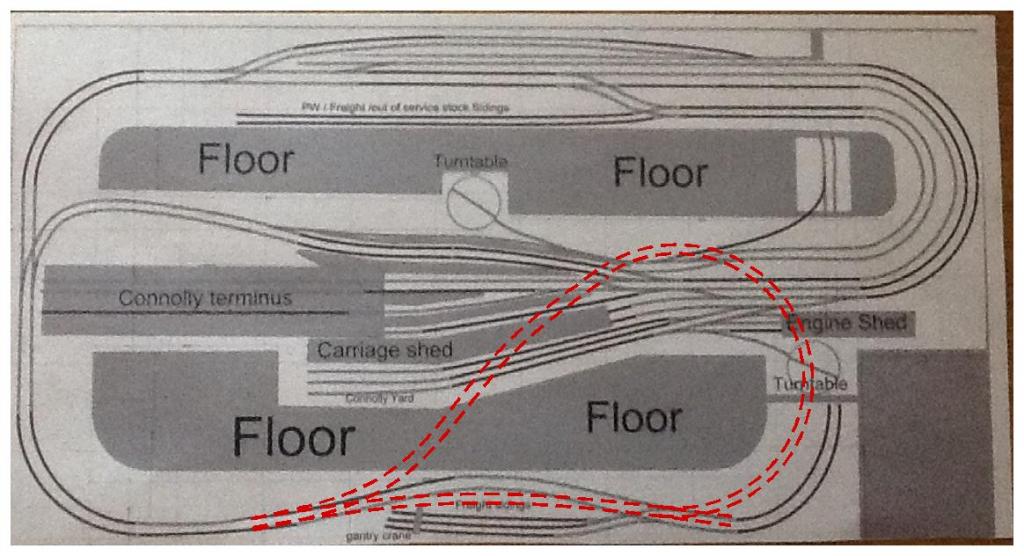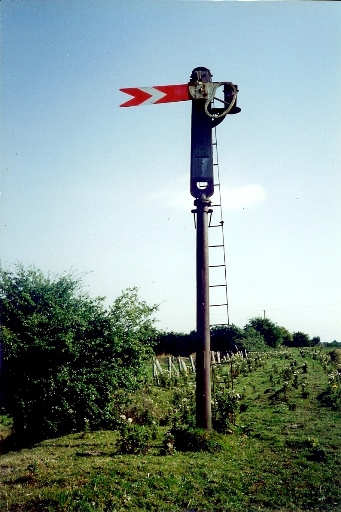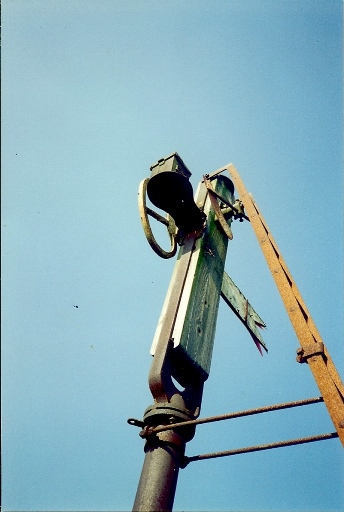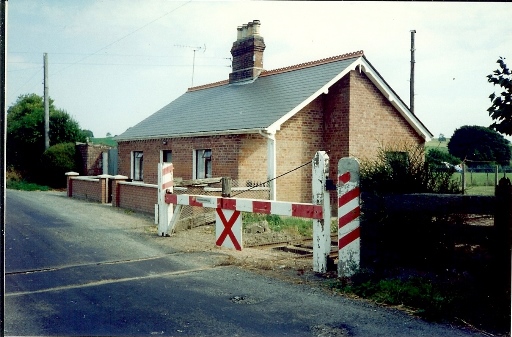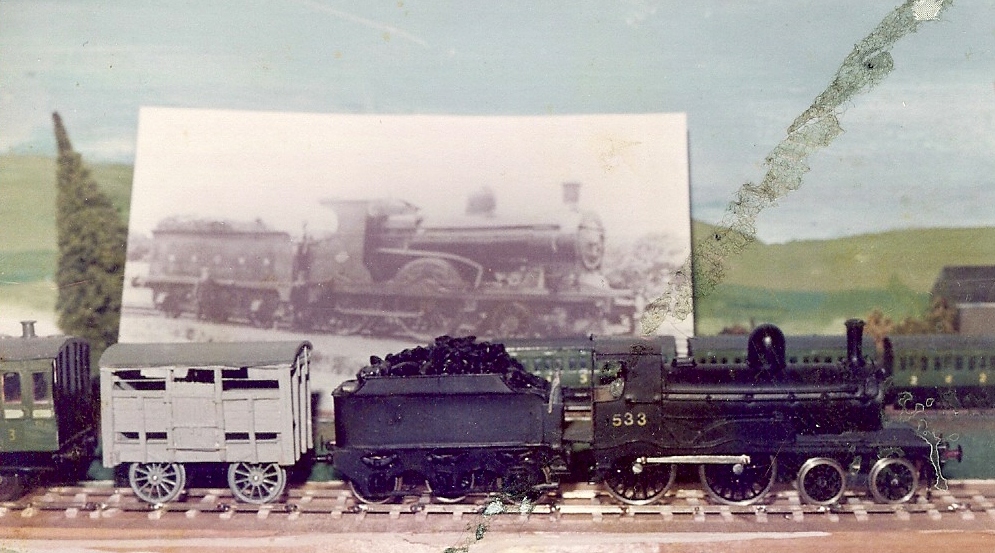-
Posts
4,196 -
Joined
-
Last visited
-
Days Won
96
Content Type
Profiles
Forums
Resource Library
Events
Gallery
Blogs
Store
Community Map
Everything posted by Mayner
-
I am surprised that no one commented that there is no direct provision for reversing or turning a North or West bound train to return to the terminus. A second return loop in the Sherriff St-Seville place area would overcome this problem and allow trains to work out and back to Connolly without the need to shunt or handle the trains. I would probably be best to forget about freight and concentrate on the passenger side of the operation which is very busy by Irish standards. There may be room to include some hidden staging for passenger trains around the reverse loop
-

The Official Irish 'Might Have Beens' Thread
Mayner replied to minister_for_hardship's topic in General Chat
Poor proof reading I had meant the County Down not the Donegal 1939 operating ratios CDJR 81.85%, GSR 92.41, GNR 98.80, BCDR 103.43, NCC105.98, SLNCR 108.85,LLSR 121.90, CVR 264.64. 80% or lower is considered to be desirable for a railway In the late 19th Century 5% was considered a good return on investment for a railway. Of the big companies the GSWR, GNR(I), BNCR (NCC) & MGWR were considered to be reasonably profitable by Irish standards returning 3-4% while the DSER struggled to return 1%. -

The Official Irish 'Might Have Beens' Thread
Mayner replied to minister_for_hardship's topic in General Chat
The GSR never seems to have been given the credit that was due for some very astute financial management with MGWR financial and traffic people at the helm. Despite the drab image and age of the rolling stock the GSR was actually more profitable than its more enterprising cousins the GNR & NCC. The main problem was that none of the Irish companies were profitable enough to pay a dividend on the ordinary shares to be a worthwhile investment for institutional and mum and dad investors. The GSR had the advantage over its Northern neighbours of a better route structure with longer and more direct routes between the main centres and since 1934 a near monopoly of rail and road transport in the Free State. Given its way the GSR was likely to have been as ruthless in closing un-profitable lines, with over 900 miles of line up for closure in 1939. The make do and mend small loco policy of the 30s may have been influenced by the view that there was little point in replacing locos and stock on lines that the GSR planned to close. The take over of the Grand Canal fitted in with the idea of eliminating a competitor, the canal competed with the GSR for freight traffic between Dublin-Tullamore-Athlone-Limerick & Dublin-thy-Carlow-Waterford with Irish Cement, Guinness and milling companies major shippers, the canal company had a fleet of trucks for local deliveries. In his book Green & Silver LTC Rolt compared the Grand Canal warehouses to busy railway goods sheds. The only railway that was more profitable than the GSR was the narrow gauge County Donegal. Despite it modern trains the NCC was loosing money and the County Donegal, SLNCR & Clogher Valley in dire straits. The nationalisation of the UKs railway and road service in the late 40s was driven more by socialist ideology than actual need the GWR lobbied to stay out, the formation of the UTA may have been tied in with this policy Had the Union continued with the Irish parties holding the balance of power its possible the Tories or Liberals would have remained in power and the railways remained in private hands possibly evolving into transport & logistics companies with publically funded passenger services like the post privatisation UK rail services. -

The Official Irish 'Might Have Beens' Thread
Mayner replied to minister_for_hardship's topic in General Chat
Possibly continuing direct rule with the Irish Parties holding the balance of power between the Tories or Dominion status with Ireland entering WW11 on the Allied side An amalgamation into 3 large companies in the 1920s followed by Nationalisation in the 1950s under an Irish Transport Executive. The GSWR would have taken over the West Cork and possibly the SLNCR as a logical extension of the Limerick-Sligo line with running powers to Belfast and Derry. An amalgamation of the DSER, Midland & GNR into an Irish Midland and Eastern balance the GSWR and compete with the GSWR for traffic to Rosslare, Waterford, Limerick and Sligo The NCC would remain under LMS owner ship possibly taking over the BCDR. CDJR remain as it is possibly take over the Swilly. Hard to guess how the loco and stock situation would have played out Inchacore would probably have continued on its merry way, while both the Midland & GNR had relatively modern fleets by Irish standards with little need to develop new types until the Mid 1930s. York Road would have Midlandised the BCDR loco fleet and could have imported bogie coaches from the LMS. Hard to know what could have developed after Nationalisaton would an Irish Transport Executive developed its own traction, copied BTC designs or would Harland & Woolf have become a preferred supplier of locos and rolling stock. -
So far this years efforts are mainly devoted to finishing off existing projects. Finishing off a rake of CIE Bredins seemed to be a good place to start, each coach has to be fitted with interior, roof detail, before painting, glazing and fitting replacement wheels and couplings Interiors seemed to be a good place to start, using Comet Interior "kits" basically strips of seating, plasticard & glazing for floors and partitions. A mitre box with a stop is a useful tool for cutting out seating 32 pair for a standard 64 seater coach. 64 Seater Coach interior before After The plasticard floor appears to be the correct width for the Dapol shell so its basically a matter of cutting to length, I use a NWSL Duplicutter for cutting the floor, partitions and doors to the correct length/width. Brake Standard Interior 64 seater Standard with roof vents Close up torpedo roof vents (Comet)
-
The Big Ds or SG3 were powerful locomotives, there was quite a bit written about how the NCC Moguls and Jeeps just did not have the sustained slow speed hauling power of the 0-6-0s when used on the Derry Road or Wellington Bank in the 60s. McArnold's Golden Years of the Great Northern has some hair raising tales of trains splitting and run-aways between Pomeroy and Omagh. When a coupling broke the golden rule was to put on steam and run as fact as possible to avoid a pile up when the run away section caught up with the loco and front section of the train.
-

DFDS doubles rail capacity in Ireland
Mayner replied to BosKonay's topic in What's happening on the network?
The press release had me wondering if IE was going to run an extra or a longer train. Nearly 20 years since the demise of Bell its great to see Waterford Port and DFDS becoming more pro-active about using rail and the direct sea route to the Continent. Its hard to see how land-bridging by road or rail across the UK was more economic or reliable than direct sailings to Rotterdam. To put current traffic levels into perspective for over 20 years Waterford Port & Bell competed with Dublin, Belfast & Cork ports for traffic to the UK & the Continent regularly operated 3 daily liners from Dublin, 1 each from Cork & Limerick, plus 3-4 extras on weekends. Heuston and later the Holyhead container terminal acted as a hub with CIE Liner trains connecting with the Bell Liners. -
Semi finished parts. Roll around piece of wood or metal of suitable diameter or a set of rolls. Paper is to prevent the rolls flattening the rivets! The semi-finished article, the reverse curves at the bottom were formed by flattening out the ends of the sheet and bending around a needle file handle, brass is easier than plasticard to work with will hold its shape and can be re-worked.
-
Little bit of metal bashing. Drawing glued to metal sheet with PVA, punch out rivets with GW rivet press or a centre punch. Rivet pattern punched out on rear of sheet. Traditionally the design was transferred to the metal by marking out and scribing, but its more accurate to glue the working drawing to the sheet of metal or plasticard. Shape roughly cut out with a tin snips to within 5 mm of line. Final cuts close to the cut line with a fine tin snips and tidy up with round and rectangular needle file
-
Historically a high proportion of crossings outside of station limits appear to have been protected only by distant signals, with a home signal provided if sighting of the gates was poor. The signals at some crossings were controlled by ground frames Hodson's Bay Crossing outside Athlone had up & down home and distant signals controlled by a frame, Adare had a frame with 3 working levers controlling the gate lock and distant signals. Its likely that CIE/IE had started to improve signalling at level crossings on an ad-hoc basis in response to near-miss incidents and complaints raised by drivers, resulting in quite different signalling at similar crossings on a section of line.
-
The majority of attended CX crossings had working distant signals, often with the gate functioning as home or stop signal. http://www.raiu.ie/download/pdf/accident_kiltoom.pdf is a report into an incident with a level crossing protected by worked distant signals with insufficient stopping distance. The majority of distant signals on the Kingscourt branch were fixed at caution as the majority of crossings were operated by the train crew. Signals included some interesting 19th Century specimens that may have dated from N&K days. Distant signal near Castletown Kilmainhamwood crossing
-
Chester MRC Dingle layout. I also have a small C&L layout. I am not sure if the business is still in operation, the last time I was in contact with the owner Pete McParin he commented that the information on the web site was out of date and no longer prepared to supply the Irish kits. The kits were relatively straightforward to assemble, though it could be a bit tricky fitting a motor under the bonnet of a Donegal railcar
-

Claremorris - Ballina 1988
Mayner replied to jhb171achill's topic in Photos & Videos of the Prototype
Although I know the area reasonably well I only travelled once on the train from Ballina to Claremorris. Earlier in the day I had taken the bus from Westport to Ballina. The train was made up of a Park Royal and a BR Van with 3-4 teenage passenger, one of whom commented that it was only "a fart of a train" Maybe it was because of the insignificance of the little train, but nothing prepared me for the sheer remoteness of the view over Lough Cullin towards the Nephin Mountains between Foxford and Pollock. The noise of the locomotive and lively ride of the Park Royal coaches on a springy trackbed contributed to the feeling of being on a very small boat on a very large ocean. Possibly the closest in Ireland in terms of scenery and isolation to the Clifden and Achill Branches. The rest of the journey home behind an 071 in MK3 comfort was totally un-remarkable by comparison with the Buffet Car attendant complaining that he was worked off his feet frying chips and burgers in a rail borne Mc Donalds. -
Harry I should be able to sort out a riveted smokebox overlay for you. The locos ran with the original flush smokebox and tall cast iron chimney into the 1940s
-
Legally the Notice was not worth the piece of tin it was printed on : IE would have had a duty under Common Law and h&s legislation to ensure that people who were legally on the railway were not harmed by the actions or inactions of the company or its workers. In other words ensure that the railway was maintained and operated so that it was safe to use rather than trying to hide behind lawyers.
-
Great to see that you have got it running, even as a 2-4-0 just like my loco! It takes a long time and a lot o practice to build up skill in model making, the great thing about brass and whitemetal kits is that they are usually salvageable. The one thing I would suggest is a small jewellers vice and a pin-tongs (available from Eileen's or expotools) for filing, bending and assembling components like rods.http://chestofbooks.com/home-improvement/workshop/Turning-Mechanical/Hand-Vices-And-Pin-Tongs.html
-
GSWR Carriage Diagrams 1975 H Richards & B Pender lists 10 GSWR full brakes withdrawn post 1960 with 3 in service post 1964 the last withrawn in 1970 the oldest lasting longest in typical GSWR fashion. No 18 -1905 -1964, No71-1911-1966, No1070-1908-1961, No1073-1908-1961, No1078-1908-1963, No72-1898-1962, No69-1888-1968, No72-1898-1962 No79-1887-1970,No116---1887-1962, The MGW 6w coaches probably survived longer because they were not as old as the GSWR 6w stock and the 3rds had better leg room with 5 compartments on a 30' underframe compared to 6 on a GSWR 3rd
-
The G8 & G12 were virtually indistinguishable the main difference was the (much noiser) 8 cylinder engine and lighter fabricated underframe for use on lightly used lines, the A1A A1A version of Frateschi model is similar to the G12 & 8 supplied to NZR https://en.wikipedia.org/wiki/New_Zealand_DB_class_locomotive. The 121s were a high cabbed development of the lightweight GL8 type introduced in the early 60s for use on the 5'3" gauge Victoria Railways in Australia
-
JHB Was that the famous excursion where the loco release was blocked by wagons and the passengers had to get out and push? I visited Kingscourt in an A Class hauled IRRS special around 75-6, work had just started on clearing the trackbed of the Oldcastle line from Tara Junction to the mine. The most interesting item of stock at Kingscourt was an ex-GNR 6 w ballast wagon parked by the buffers on one of the sidings at the South end of the yard. I had drawn the loading bank serving the siding closest to the running line rather than both sidings shown of the historic OSI map. There does not appear to be evidence of a loading bank at the North end of the yard. There is a 1939 J Smith photo of a cut of cattle wagons stored on the siding between the head shunt and the loco shed but no sign of a loading bank. The whole area was obliterated with the construction of the gypsum loading ramp and turntable. Looking at the OSI map and Eiretrains photos the most likely place for loading cattle was the loading bank on the goods shed road. http://eiretrains.com/Photo_Gallery/Railway%20Stations%20K/Kingscourt/IrishRailwayStations.html#Kingscourt_20040801_002_CC_JA.jpg It’s possible that cattle traffic may not have been heavy enough to justify a dedicated cattle bank and siding at Kingscourt. A large proportion of cattle traffic on the Midland was tied up with the seasonal movement of cattle from fairs in the West to farms in Meath and Kildare for fattening , a situation that would not arise to the same extent on an area that specialised in dairy farming and pork & bacon production.
-

Smaller UK/US Model Stores - Has anyone ever used/bought from?
Mayner replied to Blu Bianco's question in Questions & Answers
I can certainly recommend Digitrax for durability and after sales service. I have used the mid level Empire Builder based system for over 16 years in N, HO, On30 and G Scale. The original DB 150 command stations are still going strong but I upgraded the system to radio control about 7 years ago with a combination of dual knob and utility throttles. I mainly bought from Tony's Trains Exchange in both Ireland and here in New Zealand. -
I travelled over the like in 1975 or 76 and drew a sketch of the track layout. There was the remains of a loading bank between the two sidings at the south end of the station, the bank appears on the OS 25" map of the area. There did not appear to be room on loading bank by the goods shed road for loading cattle as this was covered by an extension to the goods shed. At the time gypsum was carried in a mixture of hoppers and open wagons and the sidings were in use for wagon storage.
-
I built a model of 533 in plasticard powered by a Lima tender drive about 30 odd years ago looked nice but getting it to run was another matter . The cattle wagon cast in resin (gooey) in a rubber mould the coach in plasticard from an over scale drawing. Drawings of the D16 and MGWR coaches appeared in a series of articles by Tim Cramer in Model Railways I would look at doing a D16 at some stage after the introduction of the G2 which should be available late autumn. The main issue with designing a kit for many locos is the sheer number of variation that arose in GSR/CIE days.
-
Its an interesting discussion in a way the original posters fantasy of a European railway using locally built GM locos came true with the Swedish firm Nohab building a European twin cabbed version of the classic F7 widely used across much of Europe even showing up in Turkey and Egypt. https://en.wikipedia.org/wiki/DSB_Class_MY An Irish MY is an interesting might have been as Nohab tendered to supply locos to the GNR and possibly CIE.
-
Stopped waiting parts just like many a CIE loco in the 40s & 50s. I managed to ring the end off one of the coupling rods during assembly I should have a replacement set during the next month or so.
-
Harry It would be worth while to keep the original brass chassis in reserve as a spare if you run into problems or decide at some stage to have a go at 21mm gauge I have a J26 still going strong on the original chassis after nearly 30 years service,which says a lot about the durability and accuracy of the original chassis. A compensated chassis is a better option for a small loco than a rigid one as you get more reliable power pick up with all wheels on the track. The axle and coupling rod centres line up accurately flex-chassis bearings simply slot into the openings in the frames. I used U shaped strips of scrap bass soldered to the inside of the frame to prevent the bearings revolving & made up a keeper plate from strip brass to prevent the wheels dropping out
.png.c363cdf5c3fb7955cd92a55eb6dbbae0.png)

